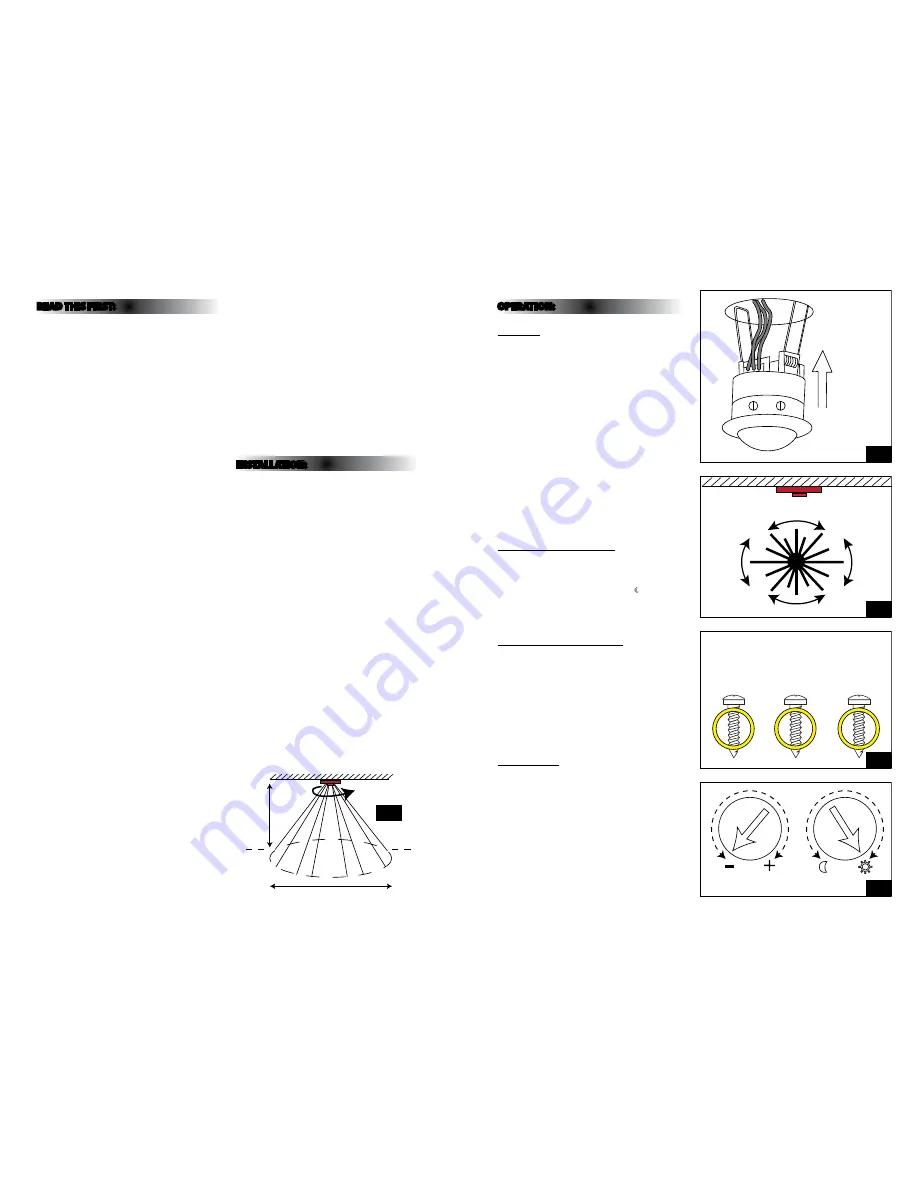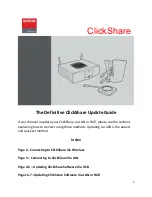
OPERATION:
WALK TEST
When the power is switched on, the unit will enter
it’s “warm up” mode for approximately 1 minute after
which it will enter “auto” mode. When the sensor is in
“auto” mode, a walk test can be performed.
With the Lux control set to daylight (
R
) and the time
control set to minimum (you should have done this
when you fitted the unit into your ceiling), you will be
able to determine the area of detection by walking
slowly beneath the sensor. The load will be switched
on for a pre-set period of time when the sensor is
triggered.
Please note that the sensor is more sensitive to
movement past it than to movement directly towards
it, see diagram opposite.
After completing the walk test, set the Lux control
to the night position (if night-time only operation
is required) and set the time control to achieve the
desired time on duration.
ADJUSTING THE LUX CONTROL
The Lux control has a built-in photocell that detects
daylight and darkness. Turning the control towards the
(
R
) symbol will result in the unit switching in all light
levels. Turning the control towards the ( ) symbol will
result in the unit switching only in reduced light. Set
the unit to switch at the desired light level using this
control.
ADJUSTING THE DURATION TIME
The duration time is the length of time for which the
load remains energised after the sensor has been
triggered. This time can be adjusted from 10±5
seconds to 14±1 minutes. Turning the control from the
[+] symbol to the [-] symbol will reduce the duration
time.
NOTE:
Once the sensor has been triggered, any
subsequent detection will start the time period again
from the beginning.
RESPONSE TIME
It is normal for a delay of several seconds to occur
between the sensor detecting movement and the load
switching on.
READ THIS FIRST:
This light fitting must be installed in accordance
with the Building Regulations making reference to
the current edition of the IEE Wiring Regulations
(BS7671).
Switch off the mains before commencing installation
and remove the appropriate circuit fuse.
Disconnect the unit from the electrical supply before
flash or high voltage testing.
Do not connect to a circuit which also has large
inductive loads connected as spikes generated
switching inductive loads may damage electronic
components within your PIR switch.
Suitable for indoor use only.
The sensor is designed for optimum performance
when installed into a domestic ceiling.
Do not position close to or pointing at any source of
heat such as a heater or heat extraction unit or vent.
This may cause false triggering.
Do not position close to or pointing at any bright
light source as this will hinder operation of the lux
control.
Before making fixing hole, check that there are no
obstructions hidden beneath the mounting surface
such as pipes or cables.
Do not fit in surfaces which are damp, freshly painted
or otherwise electrically conductive (e.g. metallic
surfaces).
If the location of your new unit requires the provision
of a new electrical supply, the supply must conform
with the requirements of the Building Regulations
making reference to the current edition of the IEE
Wiring Regulations (BS7671).
This product is designed for permanent connection
to fixed wiring: this should be either a suitable
lighting circuit (protected with a 5 or 6 Amp MCB or
fuse) or a fused spur (with a 3 Amp fuse) via a fused
connection unit. We recommend that the supply
incorporates a switch for ease of operation.
Make connections to the electrical supply in
accordance with the following code:
Live (in/out) - Brown or Red
Neutral - Blue or Black
When making connections, ensure that the terminals
are tightened securely and that no strands of wire
protrude. Check that the terminals are tightened
onto the bared conductors and not onto any
insulation.
This fitting is double insulated, do not connect any
part to earth.
You are advised at every stage of your installation to
double-check any electrical connections you have
made. After you have completed your installation
there are electrical tests that should be carried out:
these tests are specified in the Wiring Regulations
(BS7671) referred to in the Building Regulations.
Never remove the lens cover as the sensor inside will
be damaged and any guarantee will become invalid.
When making connections, ensure that the terminals
are tightened securely and that no strands of wire
protrude. Check that the terminals are tightened
onto the bared conductors and not onto any
insulation. Wrap loose terminal blocks well with
insulating tape.
INSTALLATION:
01. Choose the location for your new PIR switch
according to the conditions listed above.
02. Cut a round hole 2 ½” (63mm) in diameter in your
mounting surface.
03. Using a small flat-bladed screwdriver, remove the
transparent cover from the mains terminals.
04. Remove the top of the cord grip from the top of
the PIR unit.
05. With the supply and load wiring hanging through
the hole in your ceiling, connect the Live in,
Live load and Neutral wires according to the
colour code above and the markings next to the
terminals. (See fig. 4 opposite).
06. Fit the cables under the cable grip and tighten
securely.
07. Press the transparent cover back into position.
08. Set the Lux control to the day position (
R
)
and the time control to minimum. (See fig. 5
opposite).
09. Press the side springs upwards against the side of
the unit and offer up into the hole in your ceiling.
(See fig. 2 opposite).
10. Release the unit into the hole allowing the
strength of the springs to hold it in position.
Ceiling
360°
3M
Max radius 4.5M
Spring upwards
and insert in hole
63mm cutout size
Movement
direction with
greatest sensor
sensitivity
N = Neutral
(load & supply)
Lin
N
Lout
Live (supply in)
Live (supply out)
Connections
TIME
LUX
Ceiling
360°
3M
Max radius 4.5M
Spring upwards
and insert in hole
63mm cutout size
Movement
direction with
greatest sensor
sensitivity
N = Neutral
(load & supply)
Lin
N
Lout
Live (supply in)
Live (supply out)
Connections
TIME
LUX
Fig 2
Fig 3
Fig 4
Fig 5
Fig 1




















